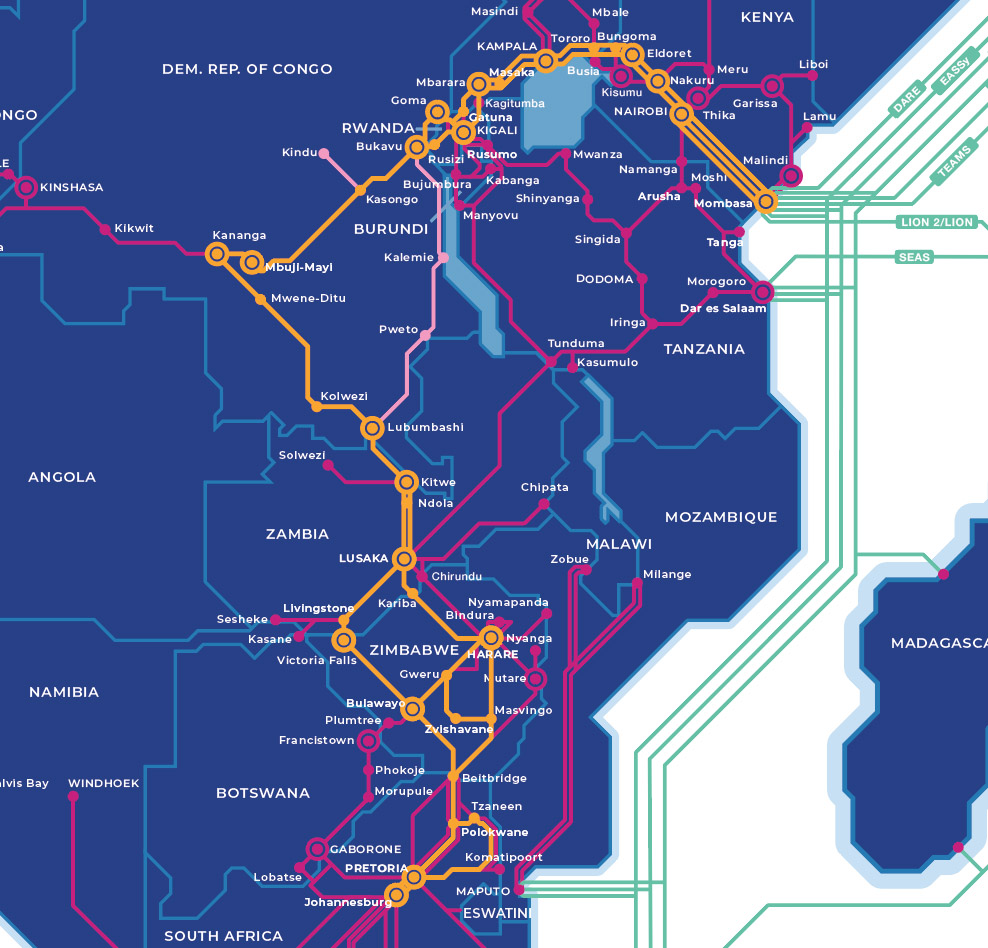Africa News
New fibre projects boost
Africa connectivity
New fibre networks announced by MTN’s Bayobab and Cassava’s Liquid will provide robust east-west and north-south links in sub-Saharan Africa, writes ARTHUR GOLDSTUCK.
Two new initiatives are set to give a massive boost to fibre-optic connectivity across sub-Saharan Africa.
On Monday, MTN announced that its pan-African Bayobab connectivity subsidiary had entered a $320-million (R6bn) partnership with the Africa50 investment platform to develop a terrestrial fibre network linking the East and West coasts of Africa, across 10 countries, in the next three years.
The following day, Liquid Dataport announced it had launched the first terrestrial fibre connecting Johannesburg to Mombasa. The company is part of Liquid Intelligent Technologies, a subsidiary of the pan-African technology group Cassava, and owner of what used to be the Neotel data centres and fibre grid.
The Bayobab-Africa50 partnership, called Project East2West, is designed to “help bridge Africa’s connectivity gap by improving broadband access for landlocked African countries”, the company said.
“This partnership with Africa50 comes at an opportune time, just as we rebrand MTN GlobalConnect to Bayobab to position the business as an Africa-focused open-access digital infrastructure platform,” said MTN group president and CEO Ralph Mupita. “The alliance is more than cables and connections; it is about building bridges of connectivity that span nations and bring people closer together.
“For landlocked African countries, Project East2West will improve latency by almost two-thirds and increase capacity to support high-quality broadband access. In this way, it will level the playing field and ensure that everyone has a fair chance to succeed in the digital world.”
CEO Bayobab Group CEO Frédéric Schepens told Business Times the demand for fibre connectivity across the sub-continent was significant.
“Approximately 900-million people on the continent are still without internet access and only about 0.4% of the African population has a fixed- broadband subscription, according to European Investment Bank estimates,” he said. “Particularly concerning is the fact that 300-million Africans live more than 50km away from a fibre or cable broadband connection. These figures highlight the stark contrast between Africa’s internet penetration rate of just 36% and the global average of 62.5%.”
He said this illustrated the pressing need for improved connectivity, presenting a valuable opportunity for growth that lies ahead.
“We continue making very good progress towards achieving our fibre ambitions and plan to roll out a total of 135,000km of fibre by 2025. With initiatives like the East to West Project, we will build the telecommunication highways that increase capacity and support high quality broadband access facilitating seamless consumption of content.”
He expected the project to have an impact on both consumption and economic growth in the region.
“The Project will greatly enhance data traffic capabilities for Internet Service Providers (ISPs), Mobile Network Operators (MNOs), and hyperscalers (large data centres). This will result in increased capacity, lower latency, and improved efficiency for internet connectivity, mitigating existing bottlenecks and strengthening global internet traffic connectivity to and from Africa.
“This large-scale infrastructure will not only enable seamless communication but also facilitate access to vital services such as education, healthcare, and e-commerce, driving socio-economic progress across the respective countries. In addition, the construction of the infrastructure itself is also expected to create numerous job opportunities, contributing and economic development in the relevant countries. By fostering the growth of digital connectivity, the Project will stimulate economic activity, promote innovation, and foster an environment conducive to sustainable growth.”
So far, the countries included in the route mapping are Kenya, Uganda, Rwanda, and the Democratic Republic of Congo (DRC).
The same countries are also on the fibre route announced this week by Liquid Dataport. The company said it included “a breakthrough and unique fibre link across DRC” and would provide multiple landlocked countries with “extra redundancy, resilience, connectivity to numerous data centres and cloud resources, and, most significantly, an alternative option in the event of a subsea cable outage between Kenya and South Africa”.
David Eurin, CEO of Liquid Dataport, said the route offered hyperscalers, enterprises and wholesale carriers direct connectivity to data centres in Johannesburg and Nairobi.
He told Business Times: “We have seen demand for bandwidth increase exponentially in Africa by at least 50% year-on-year – doubling every 18 months, faster than any other developing economy globally.
“Analysts continue to highlight the rapid growth in intra-African network traffic. Yet, there is also a wealth of sub-sea cable capacity coming into the continent over the next few years. This will bring the total available capacity to over hundreds of terabits across the oceans around Africa. It follows that this capacity needs to be made available across the continent, linking data centres together and bringing service to every building and home.”
The Mombasa-Johannesburg link will cross Kenya, Uganda, Rwanda, DRC, Zambia, Zimbabwe and South Africa.
“Navigating and building infrastructure in these difficult terrains is never easy,” said Eurin. “For example, while we were laying fibre in the DRC, in addition to traversing dense forests using sometimes poor roads, the teams on the ground had to work around extensive periods of heavy rainfalls. The build was halted in the early stage of construction when Mount Nyiragongo erupted in the Goma to safeguard the security and safety of our staff.
“Getting cables to remote regions is a challenge, and once you get connectivity to a region, network access tends to come at a fixed cost. We continue to address the rising need for connectivity by digging through savannahs, rivers, forests, villages, and towns every day, metre by metre.”

















